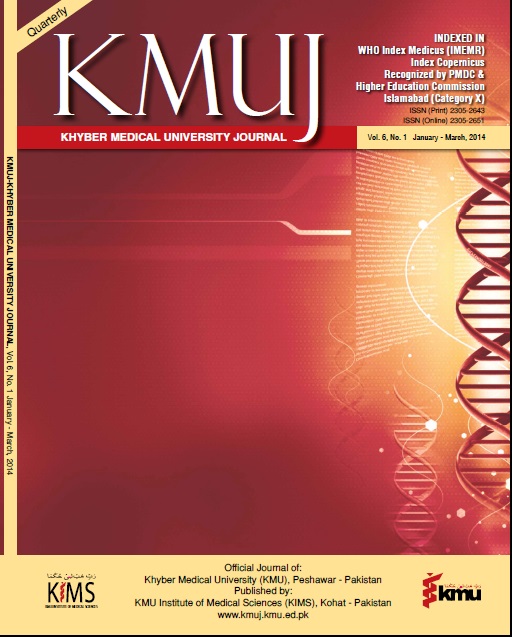FREQUENCY OF IMPROVEMENT IN ANATOMICAL ALIGNMENT OF CERVICAL SPINE WITH SKELETAL TRACTION IN PATIENTS WITH CERVICAL SPINE INJURY
Main Article Content
Abstract
OBJECTIVE: To determine frequency of improvement in anatomical alignment of cervical spine with skeletal traction in patients with cervical spine injury.
METHODOLOGY: This retrospective observational study was conducted at neurosurgery department, Lady Reading Hospital, Peshawar. The medical record of all cases from December 2010 to November 2011, in which cervical traction was applied for cervical spine injury, was retrieved. Documentation was done according to proforma designed, indicating age, sex, status of radiological alignment of cervical spine before and after cervical traction and investigations with findings on X-rays, CT and MRI. The data was analyzed with respect to mechanism of injury, type of injury, duration of traction, and reduction outcome.
RESULTS: Out of 33 patients with cervical spine injury, 21 (63.6%) were males and 12 (36.4%) were females. The age of the patients ranged from 13-80 years with mean age of 32.33+16.30 years. Majority of the patients (n=20, 60.6%) were young, ranging in age from 13-30 years. Complete radiological alignment was achieved in 20 (60.6%) cases, partial alignment in 2 (6.1%) cases and no alignment was successful in 11 (33.3%) cases. Traction was most effective in patients with C5- C6 cervical subluxation (n=13, 86.7%). Improvement was noted in 100% (n=9) of patients with posterior subluxation.
CONCLUSION: Skeletal cervical traction is safe and effective means of early decompression of spinal cord and establishing and maintaining alignment of cervical spine by close reduction. It is more effective in young individuals particularly those with subaxial spinal instability due to extension type of injury.
Article Details
Work published in KMUJ is licensed under a
Creative Commons Attribution 4.0 License
Authors are permitted and encouraged to post their work online (e.g., in institutional repositories or on their website) prior to and during the submission process, as it can lead to productive exchanges, as well as earlier and greater citation of published work.
(e.g., in institutional repositories or on their website) prior to and during the submission process, as it can lead to productive exchanges, as well as earlier and greater citation of published work.
References
Maurice King. Skeletal traction. Primary Surgery Vol 2- Trauma: the spine: Chap; 64.7, edit; May, 2008.
Principles of Traction Methods. Department of Orthopaedic Surgery - University Stellenbosch, South Africa. Cervical trac¬tion page. P 3.
Letts M, Girouard L, Yeadon A. Mechanical evaluation of four-versus eight pin halo fixation. J Pediatr Orthop 1997; 17: 121-4.
Nikunj D. Maru MS: The functional and neurological outcome in cervical spine injuries: A Retrospective Review. Internet J Orthoped Surg 2010; 17( 1): Available from URL: http://ispub.com/ IJOS/17/1/10336
Riaz S, Kortbeek FB, Mahood JK. Flex¬ion-Distraction Injuries of the Cervical Spine. J Pak Med Assoc 2007; 57 (2): 103-4.
Crutchfield W. Skeletal traction in treat¬ment of injuries to the cervical spine. J Am Med Assoc 1954; 155(1): 29-32.
Key A. Cervical spine dislocations with unilateral facet interlocking. Paraplegia 1975; 13: 208-15.
Shapiro S. Management of unilateral locked facet of the cervical spine. Neuro¬surgery 1993; 33: 832-7.
Grant GA, Mirza SK, Chapman JR, Winn HR, Newell DW, Jones DT, et al. Risk of early closed reduction in cervical spine subluxation injuries. J Neurosurg (Spine 1) 1999; 90: 13-8.
Van Middendorp JJ, Slooff WBM, Nel¬lestein WR, Öner FC. Incidence of and Risk Factors for Complications Associated with Halo-Vest Immobilization: A Prospective, Descriptive Cohort Study of 239 Patients. J Bone Joint Surg (Am) 2009; 91: 71-9.
Vital J, Gille O, Senegas J, Pointillart V. Re¬duction technique for uni- and biarticular dislocations of the cervical spine. Spine 23: 949-55, 1998.
Maiman D, Barolat G, Larson S. Manage¬ment of bilateral locked facets of the cer¬vical spine. Neurosurgery 1986; 18: 542-7.
Hadley MN, Argires PJ. The acute/emer¬gent management of vertebral column fracture dislocation injuries in neurological emergencies. The American Association of Neurological Surgeons, Park Ridge, IL. 1994( II); 249-62.
Sonntag VKH. Management of bilateral locked facets of the cervical spine. Neu-rosurgery 1981; 8: 150-2.
Lee A, Maclean J, Newton D. Rapid traction for reduction of cervical spine dislocation. J Bone Joint Surgery (Br) 1994; 76-B: 352-6.
